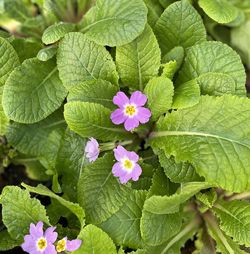Carex
Sedge
A diverse genus comprised of nearly 1000 species, most Carex originate in the moist habitats of temperate climates. Easily grown, our winning selections produce a variety of different colored leaves that promise to soften those sharp edges in your garden.
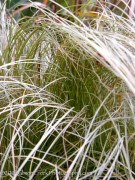
Applauded as one of the most distinctive native New Zealand grasses, this Carex spotlights a frosted fountain of gracefully cascading hairlike blades. The iridescent light green leaves twist their tips and gleam with pewter highlights, while staging a dense evergreen clump that spills over rocks, walls or a favored patio container.
For an especially fluid display, ‘Frosted Curls’ is best planted en masse on a slope where its trailing foliage appears to flow like water.
Size: 12" high x 12" wide.
Hardy to zone 7.
Each $11.00
Indigenous to the wooded floodplains, blackland prairies, calcium-rich glades and acidic springs of primarily the lower southeastern U.S., this robust, hard-working grass crafts a dense, well-mannered evergreen colony. Slow spreading rhizomes support the slender, arching dark green blades, glistening with verdant splendor beneath sheer pale green spring flowers that later morph into pendulous wheat-style golden-brown seed spikes. Distinguished by versatility and a lush, fine textured aspect, Cherokee Sedge is widely utilized in meadowscapes, shady borders and waterside venues as well as for erosion control and massed ground covers. It prefers moist soil and dappled light, but will abide dry sunny sites.
Blooms April–June
Size: 18" – 2' 0" high x 2' 0" – 3' 0" wide.
Hardy to zone 6.
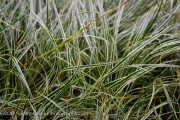
Glistening, dark green slender leaves embellished with crisp white margins and small purplish white flowers on triangular stems hallmark this neatly tufted variegated Sedge. Fully evergreen in milder climates, the sturdy fine textured mound spreads slowly, casting a long lasting sprightly charm upon the rockery, woodland beds or patio pots. ‘Snowline’ relishes light shade and loose moist soil, withstands tree roots, wards off deer and, if planted closely, makes a picturesque easy to maintain ground cover.
Blooms May
Size: 9" – 15" high x 10" – 18" wide.
Hardy to zone 5.
Each $11.00
Endemic to Europe and Asia, Grassland Sedge’s deep green and lustrous, thin evergreen blades nimbly arch out from a clumping base, yielding inconspicuous brownish blooms held by lax wiry stems. Once established, the fast growing and versatile Carex divulsa can handle an array of situations: some drought, boggy areas, tree roots, sun or shade, and foot traffic, including the 4-legged kind. However, regular watering and a trim every 6 months will ensure the most vigorous growth. You can space it closely and mow for a turf-like effect, plant multiples as a luxurious ground cover in a small or large area or create an intriguing vignette with Arctostaphylos ‘Radiant’ and Festuca ‘Superba’.
Blooms May–June
Size: 18" – 2' 0" high x 2' 0" wide.
Hardy to zone 7.
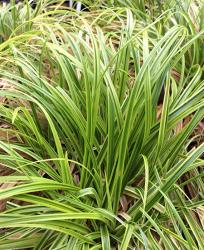
Nishiki means “brocade,” and it rightly describes the variegated blades of this superb selection, which comes to our country from Japan’s Gotemba Nursery. Forming a tidy, fountain-like mound, each slender leaf has a green central stripe emargined in radiant yellow. Long-lived and durable, ‘Kaga Nishiki’ imparts bright accents to verdant broad-leafed perennials in the border.
Size: 8" – 10" high x 18" wide.
Hardy to zone 6.
Each $11.75
“A very beautiful sedge” is how E. A. Bowles once described his prized discovery from Norfolk, England. Distinguished by subtle and variable longitudinal green stripes, this courtly, rounded sedge beams graceful clear yellow blades, which become more brilliant in sun and turn lime-yellow in shade. ‘Aurea’s dense, flowing tussock enlivens moist mixed borders, waterside plantings and rock gardens. Combine with other gilded foliage or with the contrasting leaves of Pulmonaria ‘Silver Bouquet’ and a stunning statement is yours to enjoy.
Size: 15" high x 18" wide.
Hardy to zone 5.
Carex elata ‘Knightshayes’ (G-0096)
OUT OF PRODUCTION AT THIS TIME
Email me when this plant is available
Solidly colored in clear golden yellows, this Carex's graceful hummock will energize the hohum corners of your garden. With upright and arching, evergreen foliage, 'Knightshayes' requires moisture and bright shade to retain the gilt hues. Try establishing singly or en masse near ponds, streams, in a damp border or even in water, where its glowing accents and reflections are sure to beckon.
Size: 15" high x 18" wide.
Hardy to zone 5.
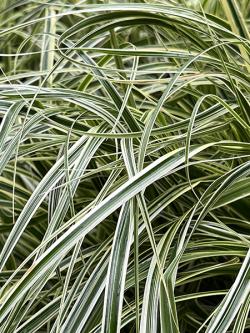
This new Exceptio Plants introduction has a lot to vaunt: sauve looks plus superb evergreen pep coupled with a fast-growing extralarge habit that’s more sun and heat tolerant than many of its Carex oshimensis kin. Dark emerald-green centers enveloped by lucent creamy-white margins garnish the gleaming cascade of long, narrow, arching variegated leaves. A premiere container showpiece, easy-care ‘Feather Falls’ can be planted as a specimen or en masse adorning slopes, pathways and shady mixed borders, while it escorts broader-leafed perennials like Saxifraga, Epimedium or Asarum. (pp#26,199)
Size: 18" – 2' 0" high x 2' 0" – 3' 0" wide.
Hardy to zone 6.
Carex flacca (glauca) (G-0099)
Each $11.00
With its sea of striking blue, Carnation-like foliage, this handsome Carex is aptly named. Glaucous, narrow blades create a noninvasive, slowly spreading mass. Purple-black spikes appear to float like a subtle mist just above the solid, jointless flowering stems. Easy to establish and indispensable as a low ground cover, Carex flacca tolerates drought, adapts to an array of growing conditions and effectively interweaves a tapestry of Heathers.
Blooms May–June
Size: 6" – 15" high x 12" – 15" wide.
Hardy to zone 4.
Carex flacca ‘Burton’s Blue’ (G-0554)
OUT OF PRODUCTION AT THIS TIME
Email me when this plant is available
Reminiscent of Dianthus leaves and noticeably broader than the species, the eye-catching ¾ in. wide ultrablue blades grow in an upward arching manner. ‘Burton’s Blue’ produces small purple-black flowers atop its compelling, textural foundation, which makes an ideal, well-behaved evergreen addition to your rock garden or border. Staged in sweeps, as a walkway edging or tucked between boulders, this adaptable slow spreading selection abides full sun, part shade, drought, alkaline soil and even some salinity.
Blooms May–mid July
Size: 12" – 20" high x 10" – 15" wide.
Hardy to zone 4.
Each $11.00
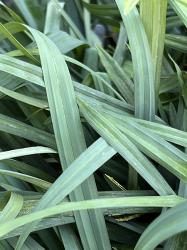
Indigenous to the central and southeastern U.S., this handsome, arching sedge sprouts low, slow-spreading evergreen clumps of narrow, glaucous blue-green leaves. Heightened by creased parallel veins and slender golden-brown seed heads, the amenable small-sized habit appreciates a late winter cutback plus shady moist abodes, yet thrives in average soil and even tolerates dry conditions. Blue Wood Sedge can flank a stream bed, edge a pathway or be utilized as a deer-resistant ground cover for wooded gardens.
Blooms May–June
Size: 6" – 10" high x 6" – 12" wide.
Hardy to zone 5.
Carex flagellifera (Bronze) (G-0532)
OUT OF PRODUCTION AT THIS TIME
Email me when this plant is available
Infused with rich earth tones evoking a Zen-like simplicity, the weeping ultra-fine clump of long and thin, dark chocolate-colored blades sets this mop-top New Zealander apart. Carex flagellifera’s easily melded tones and fluid upright arching form brings textural intrigue to containers, the rockery, walls or borders, whether installed as a stand-alone or a sweep. Arresting when juxtaposed against broad greenery, blue-gray foliage or any brightly hued bloom, Weeping Brown Sedge obliges sun, shade, moisture and somewhat dry conditions, and remains evergreen where winters are mild.
Size: 15" – 18" high x 2' 0" wide.
Hardy to zone 6.
Carex morrowii ‘Ice Dance’ (G-0088)
Each $12.00
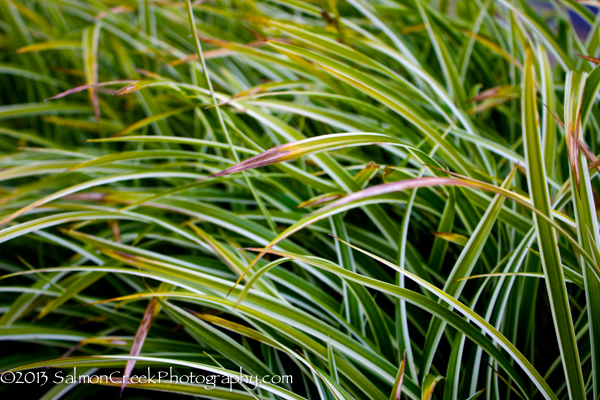
Introduced by Barry Yinger, long-lived ‘Ice Dance’ comes to us from the woodlands flanking Japan’s low-lying mountains. Dark emerald in color, the reflexed, leathery leaves are shiny and heightened by creamy white margins. This tidy evergreen ground cover is not invasive; its spreading rhizomes form a coarsely textured carpet that is somewhat drought tolerant once established.
Size: 12" high x 12" wide.
Hardy to zone 5.
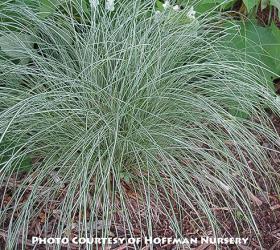
Whatever visions the cultivar name may conjure, the thread-like glimmering foliage is sure to champion. Collected by Barry Yinger during a 1970 Japanese excursion, this carefree variegated grass generates a touchable fountain-shaped mop of extrathin, longitudinally-striped green and white foliage that shrugs off deer and readily subdues angular features. ‘Silk Tassel’s elegantly cascading clump looks fantastic massed in a woodland planting, lodged alongside rocks or positioned pondside.
Size: 12" high x 2' 0" wide.
Hardy to zone 5.
Carex muskingumensis ‘Little Midge’ (G-0521)
Each $11.00
Truly pint-sized in all aspects, this easily cultivated fine-hewn Sedge was introduced by Limerock Nursery of Pennsylvania. Thin, tapered bright green blades resemble palms as they radiate out from relaxed stem tips. Best enjoyed up close, the slow spreading ‘Little Midge’ is a superb option for containers, bog gardens, the rockery, small water features or en masse plantings, which once established mimic a verdant rug. Dwarf Palm Sedge thrives with ample moisture, but is tolerant of drier conditions.
Size: 8" – 12" high x 8" – 12" wide.
Hardy to zone 4.
While the species inhabits moist North American woodlands and meadows, this uniquely textured sport, discovered in landscape architect Wolfgang Oehme’s garden, is somewhat drought tolerant once established. First a solid color, later enhanced with narrow yellow edges, the bright green blades are tapered and arranged horizontally like palm fronds on mostly upright triangular stems, knitting a tropical-styled, semideciduous ground cover.
Versatile and deer resistant, ‘Oehme’s slow spreading steadfast clump produces chocolate-colored spiky inflorescences, handles sun or shade, favors ample moisture, especially when its hot and looks just right along a walkway, streamside, or in a container.
Blooms June
Size: 18" – 2' 0" high x 2' 0" wide.
Hardy to zone 4.
Touted as one of the most graceful of the variegated sedges, this clump-forming evergreen Carex captivates us with dense and dapper, gracefully weeping blades. A butter-colored median band daringly lights up each long, fine textured dark green leaf. Carex oshimensis dwells amid the rock-laden slopes and dry woodlands on Japan’s main island, Honshu, rendering ‘Evergold’ a choice contender for your favorite pot, the rockery or woods. Smoothing over hard edges and luminous en masse, it happily obliges varied conditions, except intense hot weather.
Size: 10" – 14" high x 12" – 2' 0" wide.
Hardy to zone 6.
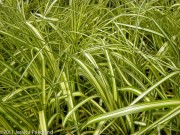
Arching upward and out, this Carex’s lush foliage is elegant. A glinting cascade of refined, evergreen blades presents dark green margins with broad, alabaster-colored central stripes that mature to creamy yellow. Languishing if it’s too hot, slow spreading ‘Gold Strike’ thrives in moist, well drained sites, and makes a bold statement when its densely set, variegated tussocks are planted in a meandering swath amidst Pulmonaria ‘Benediction’ or Epimediums.
Size: 15" – 20" high x 2' 0" wide.
Hardy to zone 6.
Each $11.00
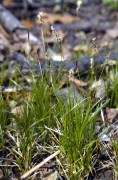
Wish you had a plush green no-mow carpet that can tackle dry conditions and requires little care? This low-growing, fine textured Sedge may be just what you’re looking for. Slowly spreading by reddish brown rhizomes, Carex pensylvanica makes a soft-looking fountain-like ground cover with delicate semievergreen blades plus white-edged purple and brown thimble-shaped inflorescences. Indigenous to the thickets and oak inhabited woodlands of eastern and central North America, Oak Sedge prospers in well-drained shady expanses, such as underneath deciduous trees and large perennials, or as a lawn substitute, where there’s not much foot traffic.
Blooms May
Size: 6" – 12" high x 8" – 15" wide.
Hardy to zone 4.
Carex pensylvanica ‘Straw Hat’ (G-0586)
Each $12.00
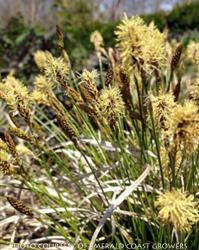
The bevy of eye-catching ½ in. wide, woolly, flaxen-yellow inflorescences achieves a showier and more generous display than its native North American counterpart. Evoking the namesake, ‘Straw Hat’s sprightly springtime blooms crest arching stalks and ultrathin semievergreen blades. Supported by slow-creeping rhizomes, the low, soft-looking medium green mound can be planted in drifts to create a pleasing grassy ground cover that relishes sun-dappled shade, loose well-drained loam and somewhat dry sites. (pp#29,423)
Blooms mid April–May
Size: 9" – 12" high x 12" – 15" wide.
Hardy to zone 4.
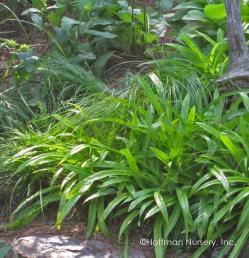
Deemed one of the most striking native woodland sedges, Carex plantaginea ranges from Maine to South Carolina and west to Minnesota and Alabama. Crafting a snug, lustrous deer-proof clump that’s most effective when massed, the dimpled, 1 in. wide lime-green blades are anchored by maroon-hued leaf sheathes beneath a bird-friendly display of cylindrical purplish brown inflorescences. Small-statured Seersucker Sedge promises bold mostly evergreen texture along woodland pathways or in mixed borders and rock gardens, where it withstands occasional drought, yet appreciates rich, adequately-moist niches plus a late winter cut back.
Blooms April–May
Size: 8" – 12" high x 12" – 18" wide.
Hardy to zone 4.
OUT OF PRODUCTION AT THIS TIME
Email me when this plant is available
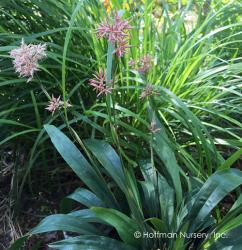
Head-turning spiky pink flowers on sturdy scapes make this exceptional new grass a standout among Carex. Native to both Vietnam and Southern China, Carex scaposa was recently discovered by U.S. National Arboretum director, Dr. Richard Olsen, at Kunming Botanical Garden. The unique, honeybee-friendly inflorescences garnish handsome, broad green blades—arching, lustrous and somewhat lax—each sporting a long tapered point. Tailor-made for shady patio containers and other low-light garden niches, aptly named Cherry Blossom Sedge vows a repeat bloom in autumn plus a lush, nearly evergreen habit that partners well with Pulmonaria ‘Diana Clare’, Beesia deltophylla and Athyrium ‘Ghost’.
Blooms mid July–August & late September
Size: 12" high x 18" – 2' 0" wide.
Zone 6b.
Carex ‘Silver Sceptre’ (G-0561)
Each $11.75
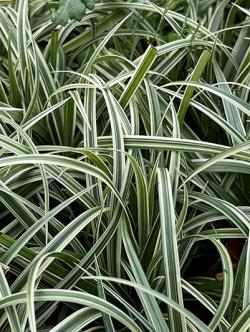
Originally cultivated by Japan’s variegated grass enthusiast, the late Dr. Yokoi, slow spreading ‘Silver Sceptre’ yields bright white margins that are big on sparkle, though the long, arching narrow green blades span a mere 1/8 in. Greenish brown flower spikes lend subtle interest on triangular stems, while the compelling silver-laced foliar accents jazz up containers or massed plantings. Utilized as an obliging evergreen ground cover, ‘Silver Sceptre's refined habit tackles deer, drought and various soil conditions plus heavy shade and cold winters.
Blooms May
Size: 8" – 12" high x 12" – 18" wide.
Hardy to zone 5.
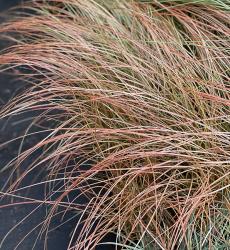
A cozy fusion of colors—from dark chocolate and cappuccino to reddish bronze—distinguish this fine textured evergreen sedge. Whether positioned in a border, cascading over a wall or embellishing a container, the long and narrow, arching foliage fashions a loosely arranged, graceful mound whose rich warm tones juxtapose green and golden leafage to great affect.
Carex tenuiculmis favors moist soil, and can be brought inside wherever it’s not winter hardy.
Size: 12" – 15" high x 12" – 15" wide.
Hardy to zone 7.
Each $11.00
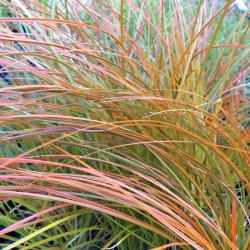
The exotic flair of lucent orange foliage paints the garden’s leafy green canvas nearly year round. Long narrow strands first emerge an olive green and later transmute stunning golden brown, copper and orange highlights. With its upright and dense arching tuft, easy-to-grow Carex testacea is a hardy drought-tolerant grass that entices gardeners, but not deer, plus insists on full sun to preserve the extraordinary hues, and good drainage. Let this evergreen New Zealand native spill over a container’s edge or snuggle up to Yucca ‘Color Guard’, Heuchera ‘Blackout’ and Euphorbia myrsinites.
Size: 18" – 2' 0" high x 18" wide.
Hardy to zone 6.
This refined Carex’s calling card is the sassy orange, red and copper tones that infuse its slim foliage with scene-stealing allure. Projecting the most vibrant coloration in full sun, the graceful greenish bronze blades are upright and arching beneath subtle mahogany-colored flowers. Appreciative of moist well-drained soil, ‘Prairie Fire’s close-knit mostly evergreen tuft brings electrifying, easy-care accents to containers, mixed borders or rock wall plantings, where it withstands dry conditions once established and enlivens gloomy winter days in milder locales.
Blooms July–August
Size: 18" – 2' 0" high x 18" – 2' 0" wide.
Hardy to zone 6.
Each $11.00
Sauntering throughout open woodlands and dry sandy meadows from New York to Georgia and west to Nebraska and Texas, this resourceful evergreen Carex serves up small, flowing mat-like clumps characterized by thin, wispy dark green leaves plus petite green flower spikes. A long-lived undemanding grass, Catlin Sedge abates erosion, prefers dappled sunlight, tolerates moist or dry conditions and makes a water-wise lawn alternative that abides minimal foot traffic and rarely needs mowing. It can spread between stepping stones, carpet forest margins and accompany bonsai specimens or Japanese Maples in containers.
Blooms April–May
Size: 5" – 12" high x 12" – 2' 0" wide.
Hardy to zone 5.











